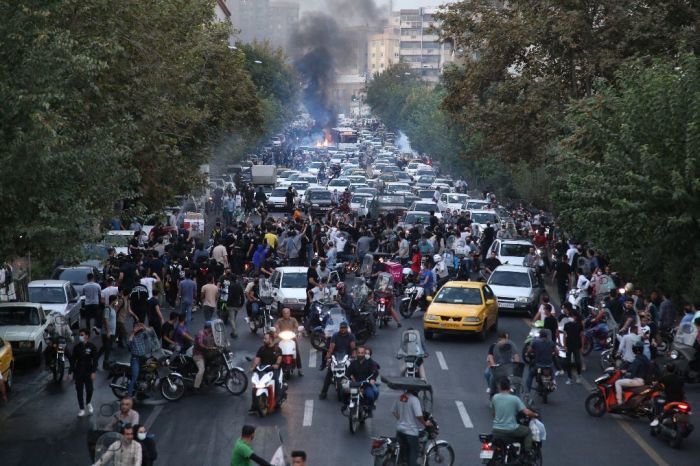Iranian Christians warned not to join uprisings as protests surpass 100 days

Iran’s security agencies have warned Assyrian and Chaldean Christians against joining the ongoing uprisings in the Islamic Republic, which surpassed 100 days over the weekend and sparked by the killing of Mahsa Amini, a young woman arrested by the “morality police” for not properly wearing a hijab.
As the Iranian government continues to crack down on protests, issuing death sentences against protesters, Assyrian community priests and Pastor Farshid Fathi, a former Christian prisoner, say they have been warned not to join the protests or post protest-related photos or messages on social media, the U.S.-based persecution watchdog International Christian Concern said.
“These groups have been pressured for many years not to go against the regime for fear of being arrested or facing worse persecution,” the watchdog said. “Because of this persecution, many Christians over the years have left Iran, leaving the dwindling Christian population smaller every year.”
Iran is ranked as the ninth worst country when it comes to Christian persecution, according to Open Doors USA’s World Watch List.
The protests against the regime are being led by students and other youth as well as members of Iran’s ethnic minorities, according to the U.S.-based group Middle East Media Research Institute.
The protestors’ motto is “Woman, Life, Freedom” to demand a society that is religious and moderate, the group says, adding that the protesters are targeting symbols of the regime.
For example, they set on fire the ancestral home of Ayatollah Ruhollah Khomeini, the father of Iran’s Islamic Revolution, in the city of Khomein, and have knocked turbans off the heads of clerics on city streets.
They have also targeted police stations and public buildings, defaced posters and statues of Iranian Supreme Leader Ali Khamenei and the late leader of Iran's Islamic Revolutionary Guards Corps Qods Force, and Qassem Soleimani, who was in charge of expanding the regime’s forces in the region.
The uprising began after morality police killed 22-year-old Amini on Sept. 16, following her detention for wearing an “improper hijab.”
The Islamic Republic’s morality police, known as Gasht-e Ershad or “Guidance Patrol,” is part of the country’s law enforcement and enforces respect for Islamic morals as described by clerical authorities.
Amini was interrogated at the Vozara detention center, where she reportedly sustained blows to the head while under interrogation. Authorities claim she died of natural causes, but critics are skeptical.
The nationwide protests are the largest in Iran since the 2019 “Green Movement,” an anti-government uprising in which 1,500 people were reportedly killed in a crackdown, according to Reuters.
Last Saturday, rallies were held in Narmak and Tehranpars neighborhoods in the east where slogans against Supreme Leader Ali Khamenei were shouted, and a march was held from Enghelab square in central Tehran toward City Theater Hall in Vali-e Asr avenue, Iran International reported.
“In Tehran a small team of protesters threw Molotov cocktails at a paramilitary Basij base, an act of defiance by young dissidents that has occurred numerous times in recent weeks,” it added.
In response, the regime is executing protestors, MEMRI reports.
In early December, the regime hanged two young men for the crime of moharbele, or war against God, and announced it intended to execute 60 others for harming members of security forces, MEMRI added, noting that it's been widely reported that security forces have fired at demonstrators, aiming at their faces and at the genitals of women protestors.
The official number of those killed is several hundred, including dozens of children, the group said.
The demonstrations began with protests against women being forced to wear the hijab, but as the regime started killing and torturing young people, the protests turned political, anti-regime and anti-Khamenei, the group explains.
The government’s crackdown has been particularly intense in Kurdish regions where security forces have put down unrest by the Kurdish minority in the past, said Reuters earlier, noting that Kurds, who form about 10% of the population, are among those who face discrimination under Iran’s Shi’ite clerical establishment.
MEMRI said the regime fears ethnic separatism which promotes secession from the Iranian state, and is, therefore, using particularly harsh tactics in the Kurdish and Baluchi regions to suppress the young people.
Hedieh Mirahmadi, who was a devout Muslim for two decades working in the field of national security before she experienced the redemptive power of Jesus Christ, urged Christians to care about the protests in Iran.
“Though the challenges are daunting, there is also a unique role for believers to share the burden faced by Iranians,” Mirahmadi from Resurrect Ministry wrote in an op-ed for The Christian Post earlier this month.
“What’s happening to Iranian protesters should move the global Church because when Christ looks at the Church, He is not seeing us as an American church versus an Iranian church or a European church. He considers the Church to be one body with Him at its head. He entrusted all members of that body with the responsibility to protect and nurture it,” wrote Mirahmadi, who is of Iranian descent.
“As the fastest-growing church in the world, millions of Iranians risk their lives every day to worship the Lord and share the Gospel. It is time that this tyranny finally comes to an end.”





























